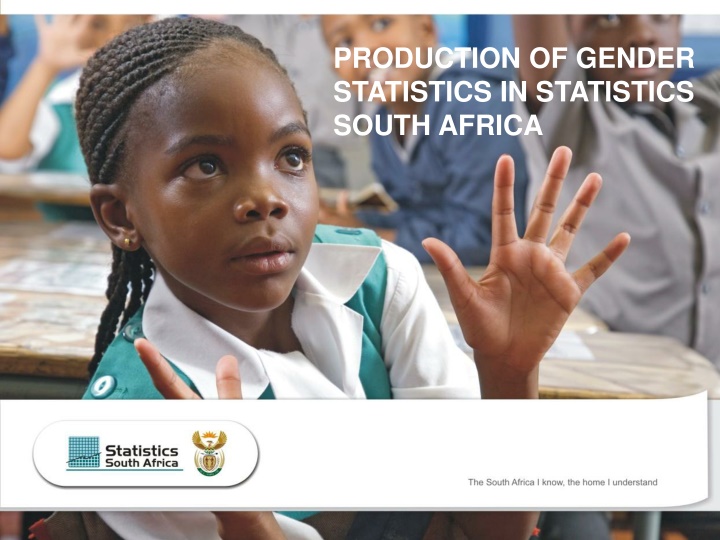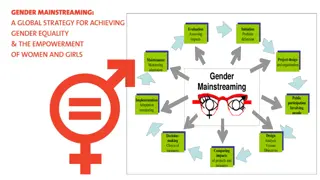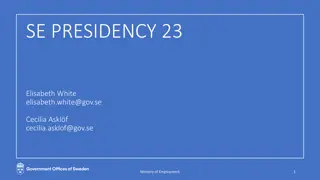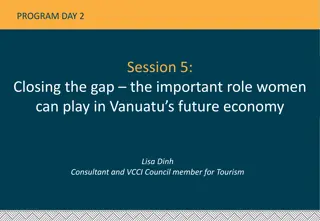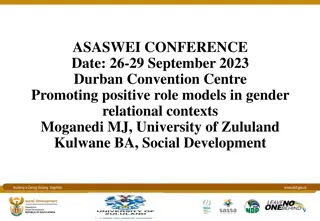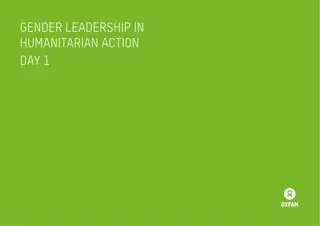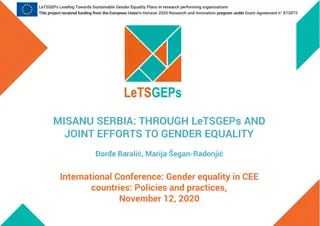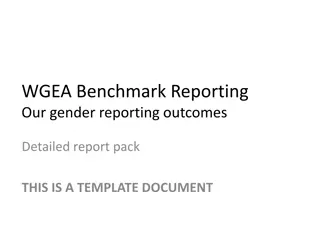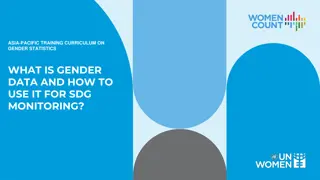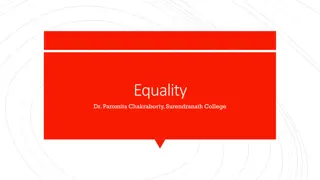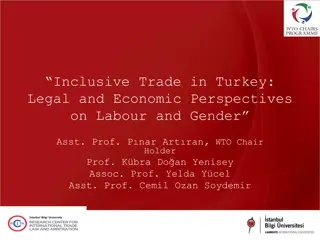Production of Gender Statistics in South Africa: Enhancing Equality Through Data
Stats SA established a Gender component in 2013 to provide relevant statistics on gender issues for policy-making. The strategy focuses on integrating gender analysis, increasing data coverage, and involving stakeholders. Approaches include tracking progress with indicators like the Millennium Development Goals. The emerging focus areas include SDGs, African Agenda 2063, asset ownership, and gender-based violence. The aim is to enhance gender equality through comprehensive statistical data.
Download Presentation

Please find below an Image/Link to download the presentation.
The content on the website is provided AS IS for your information and personal use only. It may not be sold, licensed, or shared on other websites without obtaining consent from the author.If you encounter any issues during the download, it is possible that the publisher has removed the file from their server.
You are allowed to download the files provided on this website for personal or commercial use, subject to the condition that they are used lawfully. All files are the property of their respective owners.
The content on the website is provided AS IS for your information and personal use only. It may not be sold, licensed, or shared on other websites without obtaining consent from the author.
E N D
Presentation Transcript
PRODUCTION OF GENDER STATISTICS IN STATISTICS SOUTH AFRICA
INTRODUCTION Stats SA established the Gender component formally within Social Statistics division in 2013. This is a research-based component whose scope is to provide statistics, which are focused on gender issues and which are relevant to the formulation and management of public policies, utilising both data collected and generated by Stats SA, as well as approved data from external sources. Assist government departments with the formulation of monitoring and evaluation indicators, measurement tools and data provision To date five reports comparing the life circumstances and living conditions of women and men in the country have been published: Women and Men in South Africa (1998); Women and Men in South Africa: Five years on (2002); Gender Statistics in South Africa (2013); Gender Series Volume I: Economic Empowerment 2001-2014 (2014); Gender Series Volume II: Education and Gender (will be published in Nov 2015).
STRATEGY FOR THE PRODUCTION OF GENDER STATISTICS IN STATS SA Integrate gender analysis within Stats SA Increase gender data coverage by using both internal and external data; Broaden gender stakeholder involvement; Strengthen capacity within Stats SA to analyse and address the role of gender and sex in statistics; Bringing gender into the mainstream of statistics produced within Stats SA by providing inputs into the development of gender friendly data collection tools. Participate in projects which focus on strengthening methodologies ensuring the improvement of gender data collection and analysis e.g. EDGE
APPROACHES TO ASSESS THE EXTENT TO WHICH STATS SA IS PRODUCING THE NECESSARY GENDER STATISTICS Stats SA mainly tracks progress in gender equality by following indicator instruments: The Millennium Development Goals - which includes domesticated indicators such as o Gender gaps in earnings in wage and self-employment; o The hours per day or year that women and men spend fetching water; o Percentage seats held by women in local government bodies; and o The prevalence of domestic violence. UN s Minimum international gender indicators. African Gender Development Index (AGDI)
EMERGING FOCUS AREAS SDGs African Agenda 2063 Asset Ownership through a gender lens Gender Based Violence/ Violence Against Women
CHALLENGES The non-availability of and the difficulties entailed in collecting data on issues such as gender-based violence. To date, South Africa does not have national estimates on Gender Based Violence or Violence Against Women; Lack of standardisation of indicators; Challenges in the production and dissemination of statistics in areas where there is little tradition of gendered analysis such as business statistics, transport and communication statistics; Gender mainstreaming of data collection instruments; Interface between external data owners and Stats SA.
DATA COLLECTION TOOLS Gender analyses is mostly conducted using: Secondary data collected within Stats SA, e.g. Census, the General Household Survey (GHS), Quarterly labour force survey (QLFS), Living Conditions Survey (LCS), Victims of Crime Survey (VOCS), Domestic Tourism Survey (DTS) etc. Approved external administrative data sources from National Government departments
COORDINATION AND REPORTING The coordination and reporting takes place internally and externally: Externally through national, provincial and regional structures; Internally between other Stats SA divisions as well as to work closely with the department of Women as well as the South African National Statistical System (established within Stats SA) All household based surveys that provide statistics used for gender analysis are coordinated by the Population and Social Statistics Division reporting to the DDG.
STAKEHOLDERS National Government departments e.g. Department of Women (DW), Commission for Gender Equality (CGE), Department of Social Development (DSD), etc. NGOs/Civil Society Groups International UN World Health Organisation (WHO) World Bank Southern African Development Community (SADC)
DISSEMINATION The publication of Statistical Releases is done by Social Statistics Division in conjunction with Stats SA s Printing and Communication Division. Communication Division assist with media releases, stakeholder invitations, publications print outs and placing the publications on line. One annual themed based reports (Gender Series Reports) is published annually A selection of key indicators on gender are also published on an annual bases in the publication titled Indicators of vulnerable groups
